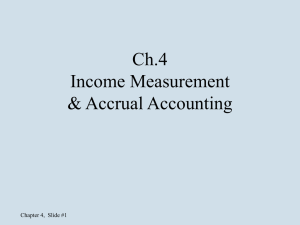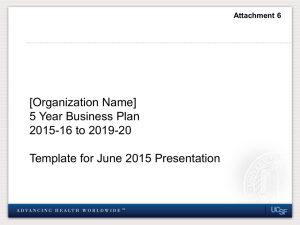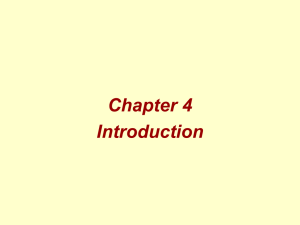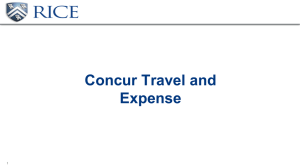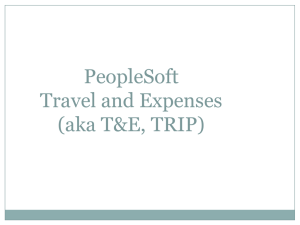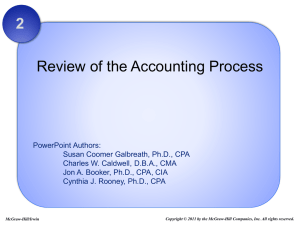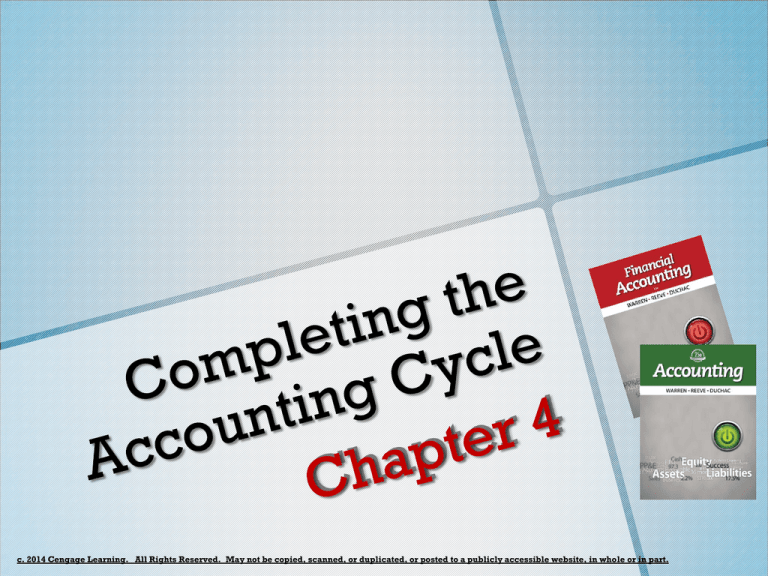
c. 2014 Cengage Learning. All Rights Reserved. May not be copied, scanned, or duplicated, or posted to a publicly accessible website, in whole or in part.
Learning Objectives
1.
Describe the flow of accounting information
from the unadjusted trial balance into the
adjusted trial balance and financial
statements.
2.
Prepare financial statements from adjusted
account balances.
3.
4.
5.
Prepare closing entries.
Describe the accounting cycle.
Illustrate the accounting cycle for one period.
Learning Objectives
6.
Explain what is meant by the fiscal year and
the natural business
7.
Describe and illustrate the use of working
capital and the current ratio in evaluating a
company’s financial condition.
c. 2014 Cengage Learning. All Rights Reserved. May not be copied, scanned, or duplicated, or posted to a publicly accessible website, in whole or in part.
FLOW OF ACCOUNTING INFORMATION
Flow of Accounting Information
End-of-Period Spreadsheet (Work Sheet)
Unadjusted TB
Accounts
Dr
Cr
Adjustments
Adjusted TB
Dr
Dr
Cr
Cr
o Account balances are listed in the Unadjusted Trial
Balance column using the ending balances found
in the general ledger.
(continued)
Flow of Accounting Information
End-of-Period Spreadsheet (Work Sheet)
Unadjusted TB
Accounts
Dr
Cr
Adjustments
Adjusted TB
Dr
Dr
Cr
Cr
o Adjustments are entered here. Two possibilities:
Deferrals – Existing balances are changed
Accruals – New information is entered
(continued)
Flow of Accounting Information
End-of-Period Spreadsheet (Work Sheet)
Unadjusted TB
Accounts
Dr
Cr
Adjustments
Adjusted TB
Dr
Dr
Cr
Cr
Adjustments are combined with the unadjusted trial
balance amounts. Account balances are now
adjusted.
(continued)
Flow of Accounting Information
End-of-Period Spreadsheet (Work Sheet)
Adjusted TB
Accounts
Dr
Cr
Income State.
Dr
Cr
Balance Sheet
Dr
Cr
o Revenue and expense balances in
the Adjusted Trial Balance column are
extended to the Income Statement column.
(continued)
Flow of Accounting Information
End-of-Period Spreadsheet (Work Sheet)
Adjusted TB
Accounts
Dr
Cr
Income State.
Dr
Cr
Balance Sheet
Dr
Cr
o Asset, liability, owner’s equity, and drawing
balances in the Adjusted Trial Balance column
are extended to the Balance Sheet column.
(concluded)
c. 2014 Cengage Learning. All Rights Reserved. May not be copied, scanned, or duplicated, or posted to a publicly accessible website, in whole or in part.
Income Statement
o The income statement is prepared directly
from the Income Statement or Adjusted Trial
Balance columns of the end-of-period
spreadsheet (work sheet) beginning with fees
earned of $16,840.
FINANCIAL STATEMENT
PREPARATION FROM
END-OF-PERIOD SPREADSHEET –
INCOME STATEMENT
to statement of owner’s equity
Statement of Owner’s Equity
o
The first item presented on the statement of
owner’s equity is the balance of the owner’s
capital account at the beginning of the period.
FINANCIAL STATEMENT
PREPARATION FROM END-OFPERIOD
SPREADSHEET – STATEMENT OF
OWNER’S EQUITY
from the income statement
to the balance sheet
Balance Sheet
o
The balance sheet is prepared directly from
the Balance Sheet or Adjusted Trial Balance
columns of the end-of-period spreadsheet (or
work sheet), beginning with Cash of $2,065.
FINANCIAL STATEMENT
PREPARATION FROM
END-OF-PERIOD SPREADSHEET –
BALANCE SHEET
from the statement of owner’s equity
Classified Balance Sheet
o
A classified balance sheet is a balance sheet
that was expanded by adding subsections for
(1) current assets, (2) property, plant, and
equipment, (3) current liabilities, and (4) longterm liabilities.
CURRENT ASSETS
Cash and other assets
that are expected to be
converted into cash,
sold, or used up usually
within a year or less,
through the normal
operations of the
business, are called
current assets.
Cash
Accounts
Receivable
Notes Receivable
Supplies
Notes Receivable
o
Notes receivable are written promises by the
customer to pay the amount of the note and
possibly interest at an agreed rate.
FIXED ASSETS
Property, plant, and
equipment (also called
fixed assets or plant
assets) include assets that
depreciate over a period
of time. Land is an
exception, since it is not
subject to depreciation.
Equipment
Machinery
Buildings
Land
CURRENT LIABILITIES
Liabilities that will be
due within a short time
(usually one year or
less) and that are to be
paid out of current
assets are called
current liabilities.
Accounts payable
Wages payable
Interest payable
Unearned fees
LONG-TERM LIABILITIES
Liabilities not due for a
long time (usually more
than one year) are
called long-term
liabilities.
Long-term notes
payable
Mortgage
payable
Bond payable
Owner’s Equity
o
Owner’s equity is the owner’s right to the
assets of the business. Owner’s equity is
added to the total liabilities, and this
combined total must be equal to the total
assets.
c. 2014 Cengage Learning. All Rights Reserved. May not be copied, scanned, or duplicated, or posted to a publicly accessible website, in whole or in part.
Closing Entries
o
Accounts that are relatively permanent from
year to year are called permanent accounts or
real accounts. These accounts are carried
forward from year to year.
Closing Entries
o Accounts that report amounts for only one
period are called temporary accounts or
nominal accounts. Temporary accounts are not
carried forward because they relate to only
one period.
Closing Entries
o
To report amounts for only one period,
temporary accounts should have zero
balances at the beginning of the next period.
o
To achieve this, the revenue and expense
account balances are transferred to Income
Summary at the end of the period.
Closing Entries
o
The balance of Income Summary (net income
or net loss) is then transferred to the owner’s
capital account.
o
The balance of the owner’s drawing account is
also transferred to the owner’s capital account.
o
The entries that transfer these balances are
called closing entries.
CLOSING ENTRIES
Closing Entries
o Income Summary is a temporary account that
is only used during the closing process.
o At the end of the closing process, the Income
Summary account will have a zero balance.
o Income Summary is sometimes called a
clearing account.
JOURNALIZING AND
POSTING CLOSING
ENTRIES
JOURNALIZING AND
POSTING CLOSING
ENTRIES
JOURNALIZING AND
POSTING CLOSING
ENTRIES
JOURNALIZING AND
POSTING CLOSING
ENTRIES
CLOSING ENTRIES
Step 1
Step 2
Step 3
Step 4
Temporary Account Balances
o
After the closing entries are posted, all of the
temporary accounts have zero balances.
LEDGER
(continued)
LEDGER
(continued)
LEDGER
(continued)
LEDGER
LEDGER
(concluded)
Post-Closing Trial Balance
o
A post-closing trial balance is prepared after
the closing entries have been posted. The
purpose of the post-closing (after closing) trial
balance is to verify that the ledger is in
balance at the beginning of the next period.
POST-CLOSING
TRIAL BALANCE
c. 2014 Cengage Learning. All Rights Reserved. May not be copied, scanned, or duplicated, or posted to a publicly accessible website, in whole or in part.
Accounting Cycle
o
The accounting process that begins with
analyzing and journalizing transactions and
ends with preparing the accounting records
for the next period’s transactions is called the
accounting cycle. There are ten steps in the
accounting cycle.
Accounting Cycle
1.
Transactions are analyzed and recorded in
the journal.
2.
3.
4.
Transactions are posted to the ledger.
5.
An optional end-of-period spreadsheet
(work sheet) is prepared.
An unadjusted trial balance is prepared.
Adjustment data are assembled and
analyzed.
(continued)
Accounting Cycle
6. Adjusting entries are journalized and posted
to the ledger.
7. An adjusted trial balance is prepared.
8. Financial statements are prepared.
9. Closing entries are journalized and posted to
the ledger.
10. A post-closing trial balance is prepared.
ACCOUNTING
CYCLE
to the
financial
statements
ACCOUNTING
CYCLE
From the adjusted
trial balance
c. 2014 Cengage Learning. All Rights Reserved. May not be copied, scanned, or duplicated, or posted to a publicly accessible website, in whole or in part.
ACCOUNTING
CYCLE
(continued)
ACCOUNTING
CYCLE
(continued)
ACCOUNTING
CYCLE
(concluded)
ACCOUNTING
CYCLE
UNADJUSTED TRIAL
BALANCE
END-OF-PERIOD
SPREADSHEET
ADJUSTING ENTRIES
ADJUSTED TRIAL
BALANCE
INCOME
STATEMENT
(continued)
STATEMENT OF
OWNER’S EQUITY
(continued)
BALANCE SHEET
(concluded)
CLOSING ENTRIES
POST-CLOSING
TRIAL BALANCE
LEDGER
(continued)
(continued)
LEDGER
(continued)
LEDGER
(concluded)
c. 2014 Cengage Learning. All Rights Reserved. May not be copied, scanned, or duplicated, or posted to a publicly accessible website, in whole or in part.
Accounting Period
o The annual accounting period adopted by a
business is known as its fiscal year.
o When a business adopts a fiscal year that ends
when business activities have reached the
lowest point in its annual operation, such a
fiscal year is also called the natural business
year.
ACCOUNTING
PERIOD
FINANCIAL
HISTORY OF A
BUSINESS
c. 2014 Cengage Learning. All Rights Reserved. May not be copied, scanned, or duplicated, or posted to a publicly accessible website, in whole or in part.
Working Capital and Current Ratio
o
The ability to convert assets into cash is called
liquidity.
Working Capital and Current Ratio
o The ability of a business to pay its debts is
called solvency.
Working Capital and Current Ratio
o Working capital is the excess of the current
assets of a business over its current liabilities.
Working Capital and Current Ratio
o NetSolutions’ working capital at the end of
2013 is $6,355 as computed below. This amount
of working capital implies that NetSolutions is
able to pay its current liabilities.
Working Capital = Current Assets – Current liabilities
= $7,745 – $1,390
= $6,355
Working Capital and Current Ratio
o The current ratio is another means of
expressing the relationship between current
assets and current liabilities. The current ratio
is computed by dividing current assets by
current liabilities.
Working Capital and Current Ratio
o The current ratio for NetSolutions at the end of
2013 is 5.6, computed as follows:
Current Ratio =
=
=
Current Assets
Current Liabilities
$7,745
$1,390
5.6 (Rounded)
c. 2014 Cengage Learning. All Rights Reserved. May not be copied, scanned, or duplicated, or posted to a publicly accessible website, in whole or in part.
Unadjusted
Trial Balance
Account Title
1
2
3
4
5
6
7
8
9
10
11
12
13
14
15
16
17
18
19
20
21
22
23
24
25
Cash
Accounts Receivable
Supplies
Prepaid Insurance
Land
Office Equipment
Accumulated Depr.
Accounts Payable
Wages Payable
Unearned Rent
Chris Clark, Capital
Chris Clark, Drawing
Fees Earned
Rent Revenue
Wages Expense
Rent Expense
Depreciation Expense
Utilities Expense
Supplies Expense
Insurance Expense
Miscellaneous Exp.
Debit
Credit
Adjusted
Trial Balance
Adjustments
Debit
Credit
Debit
Credit
2,065
2,220
2,000
2,400
20,000
1,800
900
360
25,000
4,000
16,340
4,275
1,600
The
unadjusted
trial balance
is checked
for equality.
985
800
455
42,600
42,600
81
Unadjusted
Trial Balance
Account Title
1
2
3
4
5
6
7
8
9
10
11
12
13
14
15
16
17
18
19
20
21
22
23
24
25
Cash
Accounts Receivable
Supplies
Prepaid Insurance
Land
Office Equipment
Accumulated Depr.
Accounts Payable
Wages Payable
Unearned Rent
Chris Clark, Capital
Chris Clark, Drawing
Fees Earned
Rent Revenue
Wages Expense
Rent Expense
Depreciation Expense
Utilities Expense
Supplies Expense
Insurance Expense
Miscellaneous Exp.
Debit
Credit
2,065
2,220
2,000
2,400
20,000
1,800
Adjustments
Debit
Credit
Adjusted
Trial Balance
Debit
Credit
Supplies
needs
adjusting
900
360
25,000
4,000
16,340
4,275
1,600
985
800
455
42,600
42,600
82
Unadjusted
Trial Balance
Account Title
1
2
3
4
5
6
7
8
9
10
11
12
13
14
15
16
17
18
19
20
21
22
23
24
25
Cash
Accounts Receivable
Supplies
Prepaid Insurance
Land
Office Equipment
Accumulated Depr.
Accounts Payable
Wages Payable
Unearned Rent
Chris Clark, Capital
Chris Clark, Drawing
Fees Earned
Rent Revenue
Wages Expense
Rent Expense
Depreciation Expense
Utilities Expense
Supplies Expense
Insurance Expense
Miscellaneous Exp.
Debit
Adjustments
Credit
Debit
2,065
2,220
2,000
2,400
20,000
1,800
Credit
Adjusted
Trial Balance
Debit
Credit
(a) 1,240
(a) Cost of
supplies on
hand at
December 31
is $760.
900
360
25,000
4,000
16,340
4,275
1,600
985
800
455
42,600
(a) 1,240
42,600
83
Unadjusted
Trial Balance
Account Title
1
2
3
4
5
6
7
8
9
10
11
12
13
14
15
16
17
18
19
20
21
22
23
24
25
Cash
Accounts Receivable
Supplies
Prepaid Insurance
Land
Office Equipment
Accumulated Depr.
Accounts Payable
Wages Payable
Unearned Rent
Chris Clark, Capital
Chris Clark, Drawing
Fees Earned
Rent Revenue
Wages Expense
Rent Expense
Depreciation Expense
Utilities Expense
Supplies Expense
Insurance Expense
Miscellaneous Exp.
Debit
Adjustments
Credit
Debit
2,065
2,220
2,000
2,400
20,000
1,800
Credit
Adjusted
Trial Balance
Debit
Credit
(a) 1,240
(b) 200
(b) The insurance
expense for
December is
$200 ($2,400 ÷
12).
900
360
25,000
4,000
16,340
4,275
1,600
985
800
455
42,600
(a) 1,240
(b) 200
42,600
84
Unadjusted
Trial Balance
Account Title
1
2
3
4
5
6
7
8
9
10
11
12
13
14
15
16
17
18
19
20
21
22
23
24
25
Cash
Accounts Receivable
Supplies
Prepaid Insurance
Land
Office Equipment
Accumulated Depr.
Accounts Payable
Wages Payable
Unearned Rent
Chris Clark, Capital
Chris Clark, Drawing
Fees Earned
Rent Revenue
Wages Expense
Rent Expense
Depreciation Expense
Utilities Expense
Supplies Expense
Insurance Expense
Miscellaneous Exp.
Debit
Credit
Adjusted
Trial Balance
Adjustments
Debit
2,065
2,220
2,000
2,400
20,000
1,800
Credit
Debit
Credit
(a) 1,240
(b) 200
900
360
25,000
(c)
120
4,000
16,340
(c)
120
(c) Rent
revenue
earned
during
December
was $120
($360 ÷ 3).
4,275
1,600
985
800
455
42,600
(a) 1,240
(b) 200
42,600
85
Unadjusted
Trial Balance
Account Title
1
2
3
4
5
6
7
8
9
10
11
12
13
14
15
16
17
18
19
20
21
22
23
24
25
Cash
Accounts Receivable
Supplies
Prepaid Insurance
Land
Office Equipment
Accumulated Depr.
Accounts Payable
Wages Payable
Unearned Rent
Chris Clark, Capital
Chris Clark, Drawing
Fees Earned
Rent Revenue
Wages Expense
Rent Expense
Depreciation Expense
Utilities Expense
Supplies Expense
Insurance Expense
Miscellaneous Exp.
Debit
Credit
2,065
2,220
2,000
2,400
20,000
1,800
Adjusted
Trial Balance
Adjustments
Debit
(d)
Credit
Debit
Credit
500
(a) 1,240
(b) 200
900
360
25,000
(c)
120
4,000
16,340
(d)
(c)
(d) Fees accrued
at the end of
December,
but not
recorded,
totaled $500.
500
120
4,275
1,600
985
800
455
42,600
(a) 1,240
(b) 200
42,600
86
Unadjusted
Trial Balance
Account Title
1
2
3
4
5
6
7
8
9
10
11
12
13
14
15
16
17
18
19
20
21
22
23
24
25
Cash
Accounts Receivable
Supplies
Prepaid Insurance
Land
Office Equipment
Accumulated Depr.
Accounts Payable
Wages Payable
Unearned Rent
Chris Clark, Capital
Chris Clark, Drawing
Fees Earned
Rent Revenue
Wages Expense
Rent Expense
Depreciation Expense
Utilities Expense
Supplies Expense
Insurance Expense
Miscellaneous Exp.
Debit
Credit
2,065
2,220
2,000
2,400
20,000
1,800
Adjustments
Debit
(d)
Credit
Debit
Credit
500
(a) 1,240
(b) 200
900
(e)
360
25,000
(c)
120
4,000
16,340
4,275
1,600
(d)
(c)
(e)
985
800
455
42,600
Adjusted
Trial Balance
(e) Wages
accrued, but
250
not paid, at
the end of
December
totaled $250.
500
120
250
(a) 1,240
(b) 200
42,600
87
Unadjusted
Trial Balance
Account Title
1
2
3
4
5
6
7
8
9
10
11
12
13
14
15
16
17
18
19
20
21
22
23
24
25
Cash
Accounts Receivable
Supplies
Prepaid Insurance
Land
Office Equipment
Accumulated Depr.
Accounts Payable
Wages Payable
Unearned Rent
Chris Clark, Capital
Chris Clark, Drawing
Fees Earned
Rent Revenue
Wages Expense
Rent Expense
Depreciation Expense
Utilities Expense
Supplies Expense
Insurance Expense
Miscellaneous Exp.
Debit
Credit
2,065
2,220
2,000
2,400
20,000
1,800
Adjusted
Trial Balance
Adjustments
Debit
(d)
Credit
Credit
500
(a) 1,240
(b) 200
(f)
50
(e)
250
(d)
(c)
500
120
900
360
25,000
(c)
120
4,000
16,340
4,275
1,600
985
800
455
42,600
Debit
(e)
250
(f)
50
(f) Depreciation
of office
equipment is
$50 for
December.
(a) 1,240
(b) 200
42,600
88
Unadjusted
Trial Balance
Account Title
1
2
3
4
5
6
7
8
9
10
11
12
13
14
15
16
17
18
19
20
21
22
23
24
25
Cash
Accounts Receivable
Supplies
Prepaid Insurance
Land
Office Equipment
Accumulated Depr.
Accounts Payable
Wages Payable
Unearned Rent
Chris Clark, Capital
Chris Clark, Drawing
Fees Earned
Rent Revenue
Wages Expense
Rent Expense
Depreciation Expense
Utilities Expense
Supplies Expense
Insurance Expense
Miscellaneous Exp.
Debit
Credit
2,065
2,220
2,000
2,400
20,000
1,800
Adjusted
Trial Balance
Adjustments
Debit
(d)
Credit
Debit
Credit
500
(a) 1,240
(b) 200
(f)
50
(e)
250
(d)
(c)
500
120
900
360
25,000
(c)
120
4,000
16,340
4,275
1,600
985
800
(e)
250
(f)
50
(a) 1,240
(b) 200
455
Summed
42,600 42,600
and ruled
2,360
2,360
89
Add / Subtract Adjustments
o
The next step is to add or subtract the
adjustments to (or from) the amounts found in
the Unadjusted Trial Balance columns and
enter the results in the Adjusted Trial Balance
columns.
Unadjusted
Trial Balance
Account Title
1
2
3
4
5
6
7
8
9
10
11
12
13
14
15
16
17
18
19
20
21
22
23
24
25
Cash
Accounts Receivable
Supplies
Prepaid Insurance
Land
Office Equipment
Accumulated Depr.
Accounts Payable
Wages Payable
Unearned Rent
Chris Clark, Capital
Chris Clark, Drawing
Fees Earned
Rent Revenue
Wages Expense
Rent Expense
Depreciation Expense
Utilities Expense
Supplies Expense
Insurance Expense
Miscellaneous Exp.
Debit
Credit
2,065
2,220
2,000
2,400
20,000
1,800
Adjusted
Trial Balance
Adjustments
Debit
(d)
Credit
500
(a) 1,240
(b) 200
(f)
50
(e)
250
Debit
2,065
2,720
760
2,200
20,000
1,800
50
900
250
240
25,000
900
360
25,000
(c)
120
4,000
4,000
16,340
4,275
1,600
985
800
455
42,600
Credit
(d)
(c)
(e)
250
(f)
50
(a) 1,240
(b) 200
42,600
2,360
16,840
120
500
120
2,360
4,525
1,600
50
985
2,040
200
455
43,400
43,400
91
Spreadsheet
o Preparing the work sheet as a spreadsheet
allows the computer to assist you in the
process. The spreadsheet illustrated in Exhibit
1 has been reproduced on the next slide.
Extending Amounts to Statement Columns
o The next step is to extend amounts in the
Adjusted Trial Balance columns to the Income
Statement and Balance Sheet columns. Because
of space limitations, the unadjusted trial
balance and the adjustments columns have
been removed for the remainder of this slide
presentation.
Adjusted
Trial Balance
Account Title
1
2
3
4
5
6
7
8
9
10
11
12
13
14
15
16
17
18
19
20
21
22
23
24
25
Cash
Accounts Receivable
Supplies
Prepaid Insurance
Land
Office Equipment
Accumulated Depr.
Accounts Payable
Wages Payable
Unearned Rent
Chris Clark, Capital
Chris Clark, Drawing
Fees Earned
Rent Revenue
Wages Expense
Rent Expense
Depreciation Expense
Utilities Expense
Supplies Expense
Insurance Expense
Miscellaneous Exp.
Debit
Credit
Income Statement
Debit
Credit
2,065
2,720
760
2,200
20,000
1,800
Balance Sheet
Debit
2,065
2,720
760
2,200
20,000
1,800
50
900
250
240
25,000
50
900
250
240
25,000
4,000
4,000
16,840
120
4,525
1,600
50
985
2,040
200
455
43,400
Credit
16,840
120
4,525
1,600
50
985
2,040
200
455
43,400
95
Adjusted
Trial Balance
Account Title
1
2
3
4
5
6
7
8
9
10
11
12
13
14
15
16
17
18
19
20
21
22
23
24
25
Cash
Accounts Receivable
Supplies
Prepaid Insurance
Land
Office Equipment
Accumulated Depr.
Accounts Payable
Wages Payable
Unearned Rent
Chris Clark, Capital
Chris Clark, Drawing
Fees Earned
Rent Revenue
Wages Expense
Rent Expense
Depreciation Expense
Utilities Expense
Supplies Expense
Insurance Expense
Miscellaneous Exp.
Debit
Credit
Income Statement
Debit
Credit
2,065
2,720
760
2,200
20,000
1,800
Balance Sheet
Debit
2,065
2,720
760
2,200
20,000
1,800
50
900
250
240
25,000
50
900
250
240
25,000
4,000
4,000
16,840
120
4,525
1,600
50
985
2,040
200
455
43,400
Credit
43,400
16,840
120
4,525
1,600
50
985
2,040
200
455
9,855
16,960
33,545
26,440
The four columns are summed.
96
Determining Net Income (Net Loss)
Income Statement
Balance Sheet
9,855
7,105
16,960
16,960
33,545
16,960
33,545
26,440
7,105
33,545
Net Income
o The difference between the Income Statement
column totals and Balance Sheet column totals is
net income (or net loss) for the period.
Adjusted
Trial Balance
Account Title
1
2
3
4
5
6
7
8
9
10
11
12
13
14
15
16
17
18
19
20
21
22
23
24
25
Cash
Accounts Receivable
Supplies
Prepaid Insurance
Land
Office Equipment
Accumulated Depr.
Accounts Payable
Wages Payable
Unearned Rent
Chris Clark, Capital
Chris Clark, Drawing
Fees Earned
Rent Revenue
Wages Expense
Rent Expense
Depreciation Expense
Utilities Expense
Supplies Expense
Insurance Expense
Miscellaneous Exp.
Net income
Debit
Credit
Income Statement
Debit
Credit
2,065
2,720
760
2,200
20,000
1,800
Balance Sheet
Debit
2,065
2,720
760
2,200
20,000
1,800
50
900
250
240
25,000
50
900
250
240
25,000
4,000
4,000
16,840
120
4,525
1,600
50
985
2,040
200
455
43,400
Credit
43,400
16,840
120
4,525
1,600
50
985
2,040
200
455
9,855
7,105
16,960
16,960
33,545
16,960
33,545
26,440
7,105
33,545
98
c. 2014 Cengage Learning. All Rights Reserved. May not be copied, scanned, or duplicated, or posted to a publicly accessible website, in whole or in part.

